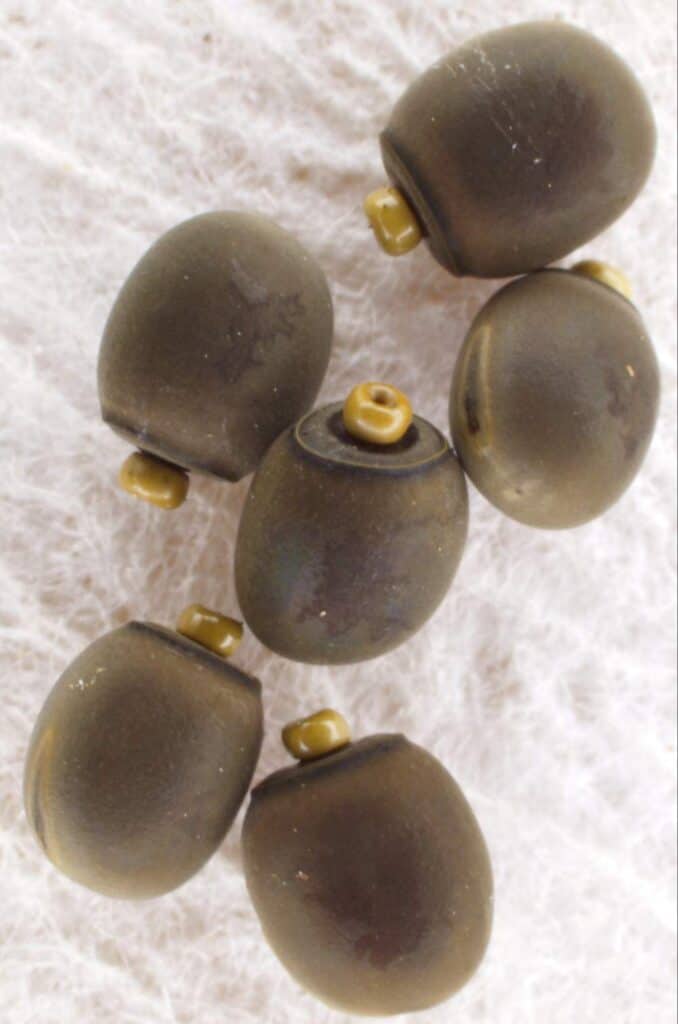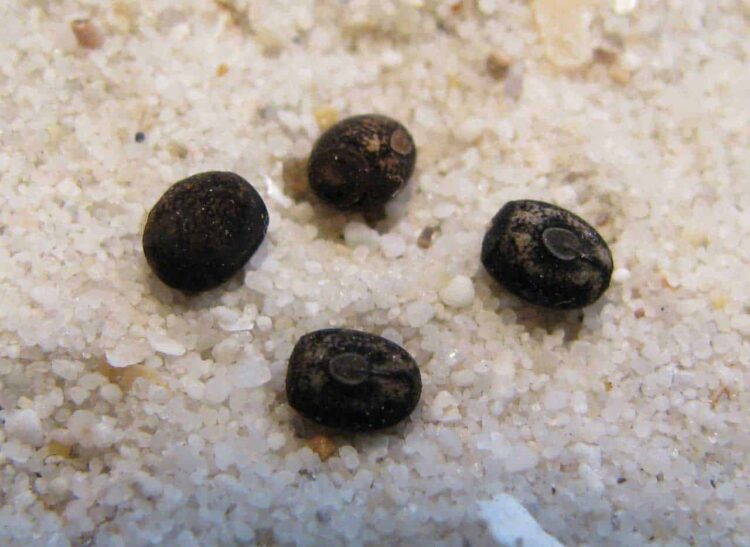Table of Contents
Some people want to keep stick insects as pets because they are fascinated with these creatures that look like walking twigs. Others decide to buy them with the intention of breeding them, either as a hobby or as a way to make a bit of extra money. Either way, you might like the answer to the question of how long do stick insect eggs take to hatch. Indeed, this question becomes more important if you have already bought a stick insect and now have eggs lying at the bottom of the tank!
Depending on the stick insect species, it can take anywhere from 7 weeks to 13-14 months for the eggs to hatch and the nymphs to start appearing.
For more advice and information on keeping and looking after stick insects, check out my ebook on Amazon click here
(opens in a new tab).

Some Stick Insects are Parthenogenic
Some, but not all, stick insects are parthenogenic . This means that they are capable of laying fertilised eggs despite not mating with a male. If you have bought a single female stick insect and have consequently found eggs at the bottom of the tank, you may have been scratching your head in astonishment. You might be further surprised to find out that, as these eggs are already fertilised, they will hatch into baby stick insects, or nymphs as they are known.
. This means that they are capable of laying fertilised eggs despite not mating with a male. If you have bought a single female stick insect and have consequently found eggs at the bottom of the tank, you may have been scratching your head in astonishment. You might be further surprised to find out that, as these eggs are already fertilised, they will hatch into baby stick insects, or nymphs as they are known.
The Indian stick insect is parthenogenic and is more often than not the species that most people will buy initially due to how easy they are to look after. Therefore, if you have acquired an Indian stick insect, do not be surprised to eventually find eggs in your tank.
When Do Stick Insects Lay Eggs?
Stick insects take around two to three months to reach maturity, but this depends on the species in question. The larger types of stick insect, such as the jungle nymph, take longer to reach adulthood and typically have a longer lifespan as well.
and typically have a longer lifespan as well.
As a stick insect matures, it will shed its skin a number of times; usually five at least. Once the stick insect has reached maturity, it will begin laying eggs. Although it will likely only lay a few eggs at a time, this could actually equate to hundreds of eggs during its lifespan.
a number of times; usually five at least. Once the stick insect has reached maturity, it will begin laying eggs. Although it will likely only lay a few eggs at a time, this could actually equate to hundreds of eggs during its lifespan.
When Will the Eggs Hatch
The issue of how long do stick insect eggs take to hatch is one that many people are curious about. After all, they want to know how long it will be before they see tiny stick insects walking about the tank. It is difficult to say for sure because the time it takes for eggs to hatch depends on the type of stick insect you have. It also depends on the conditions that the eggs have been kept in. In general, stick insect eggs can take anywhere from a couple of months up to a year to hatch.
How to Care for Stick Insect Eggs
There are a number of things that you can do to ensure the stick insect eggs hatch properly. Adult stick insects either allow their eggs to drop to the floor of the tank they are being kept in or they will bury them in soil. If you have soil at the bottom of the tank, look for eggs when you are cleaning it out. If you do find them, transfer them to a sealed but ventilated container.
If the bottom of your tank is lined with tissue paper, it will be easier to spot the eggs. They are usually around 2mm in diameter and dark brown in colour. You do not have to do very much in terms of keeping the eggs, but it is important that the conditions are suitable.
For example, stick insect eggs will do best in a warm humid environment. Ideally the temperature should remain in the mid-20s Celsius range. You will also need to make sure that you are regularly misting the eggs without allowing mould to develop; mould can be a killer for stick insect eggs.

What to Do When They Hatch
Do not be surprised to spot tiny stick insects walking about the container after a couple of months, especially if you have an Indian stick insect. The Indian stick insect is one type of stick insect that can hatch within a couple of months, depending on conditions.
When you see nymphs walking about the container, it is time to move them to the main tank. You might also have a separate tank for your adult stick insects and one for your nymphs. Either way, it is important to take them from the container they were in and place them in an appropriate tank or enclosure. Amazon has a great selection of stick insect enclosures; see some by clicking here (opens in a new tab).
(opens in a new tab).
In the case of nymphs, you should maintain the same humidity and temperature levels you have for the adult sticks, but you will need to tear or cut the leaves placed in the tank for food, or at least make sure that there are older nymphs or adults in the tank too. Newly hatched nymphs struggle to eat undamaged leaves.
You will also need to ensure that you cover any water container being used to keep leaves fresh. You can cover the container with mesh or netting and place the stem of the leaves through this, which ensures the nymphs do not fall into the water. While this may not be an issue with older sticks, nymphs can quickly drown if they fall into water, even if there is a way for them to climb out.
What Do Stick Insects Eat?
The great thing about stick insects is that they are so easy to keep. They are herbivores and eat a diet of leaves . But what leaves are best?
. But what leaves are best?
The leaves preferred by your stick insect will depend on the type of stick insect that you have. Most eat bramble leaves, such as blackberry and raspberry. Then there are other species that like ivy, privet, rose, hawthorn, and oak leaves.
leaves, such as blackberry and raspberry. Then there are other species that like ivy, privet, rose, hawthorn, and oak leaves.
The fact that most of these plants can be found in the wild makes it easy for stick insect owners to collect free food for their pets. However, care must be taken when collecting such plants as it is important to ensure that leaves are free from chemicals. Collecting leaves from the side of a busy road, for example, could be harmful for your sticks as they may be covered in chemicals from the car exhausts. So these leaves, if you insist on using them, will have to be washed thoroughly before being paced into the stick’s tank.
You might think that it is a good idea to just buy plants from the local garden centre from which you can take leaves to feed your sticks. While this is okay to do, it is crucial to be aware that most plants in a garden centre are sprayed with insecticides that could be deadly for your pet. If you are going to buy plants, once again, wash the leaves before feeding them to your stick insects.
Providing the Right Environment
Most stick insect species prefer to live in warm humid environments as they are, for the most part, tropical insects. This means maintaining a temperature of between 20C and 30C. You will also need to mist your enclosure a couple of times a week to help keep it humid (but be careful of doing this too much due to the aforementioned mould problems).
As well as placing food in the tank, put some decorations and resting places for your stick insects to enjoy. They love to climb so will appreciate things like plastic (free from too many chemicals) and wooden decorations that can be bought from a local pet store or online. Alternatively, collect some wooden branches and sticks to place in the tank.
Be Careful of Overcrowding
As mentioned already, stick insects can lay hundreds of eggs over their lifespan, so it is important to be aware of the risk of overcrowding. Allowing all these eggs to hatch can result in hundreds of stick insects.
Too many stick insects in one tank can result in a situation where some of them start to lose limbs because of the overcrowding. Stick insects are quite fragile, and they need plenty of room to move. Stick insects have been known to knock or bite the legs off other sticks in the same tank. Remember too that your stick insects will need room to moult, so having too many sticks in one place could prevent them from doing this properly.
Although young stick insects may be able to grow new limbs when they moult, this ability will cease once they have reached adulthood.

